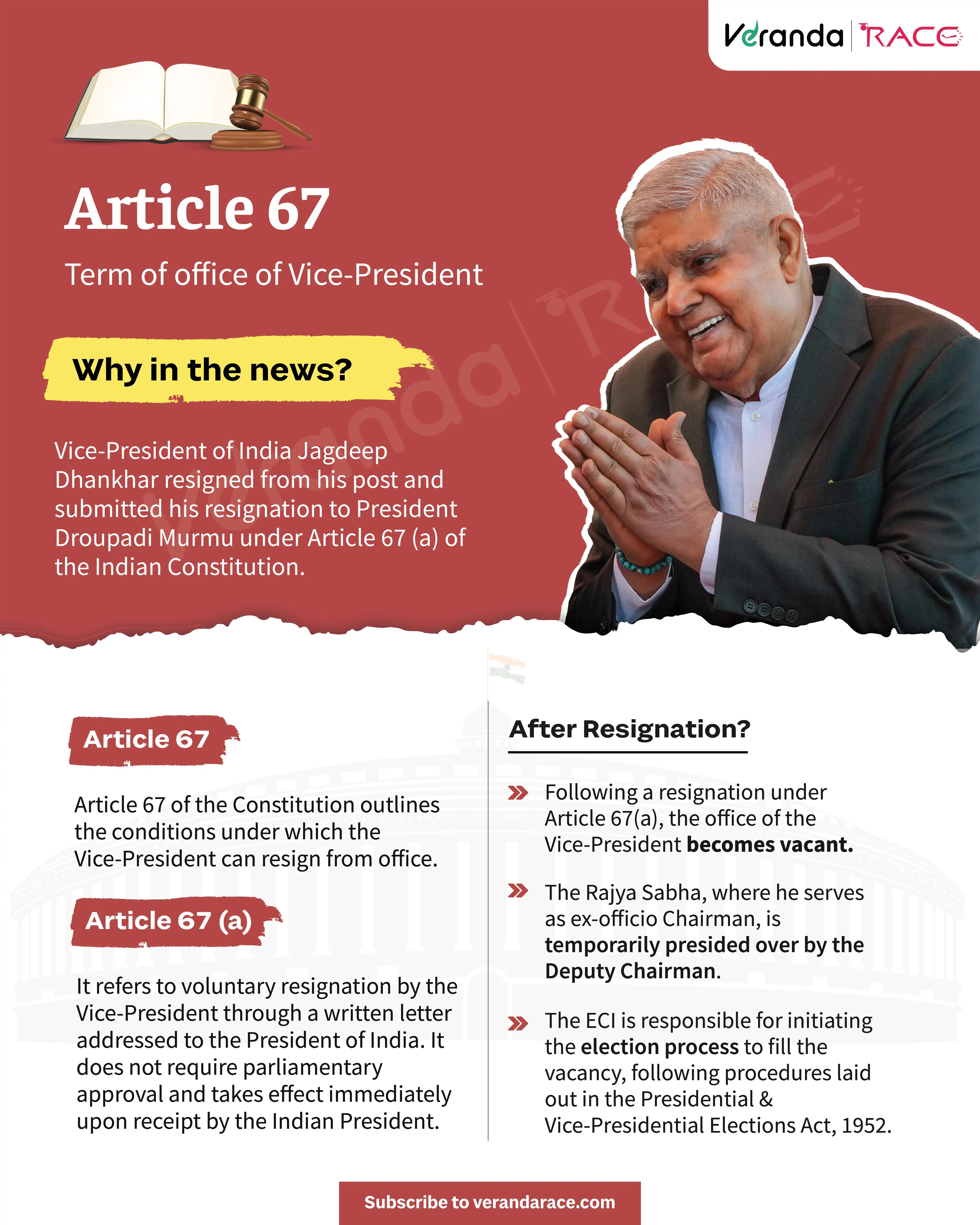
List of Vice Presidents of India from 1952 to 2025: Tenure, Powers, Functions & Important Facts
Explore the complete updated list of Vice Presidents of India starting from 1952 until 2025 along with learning in detail about their constitutional powers, functions, provisions, office tenure, eligibility criteria and other important facts about the post of the office of the Vice President in India. Discover the latest news and updates regarding the resignation of Vice President of India in 2025 and the important articles from the Indian Constitution through this Veranda RACE article.
List of Vice Presidents of India
India has had 14 Vice Presidents so far starting from 1952 with Dr. Sarvepalli Radhakrishnan, the first Vice President of India and until the resignation of the 14th Vice President of India, Jagdeep Dhankar in 2025.
Since the President of India is the highest constitutional office in India, the office of the Vice President of India is the second highest constitutional authority in India.
The Vice President of India plays a key role in India’s parliamentary system. Vice President in India is the ex-officio Chairman of the Rajya Sabha.

This article from Veranda RACE covers everything you need to know about the roles and responsibilities of the Vice President of India, including constitutional powers, resignation process, impeachment provisions, tenure, responsibilities as the Chairman of the Rajya Sabha and other key important facts about the election process of the Vice President.
Whether you're an aspirant preparing for Bank, SSC, TNPSC, UPSC CDS, NDA, CAPF, Kerala PSC or other government competitive exams or someone exploring Indian parliament and political structure, this comprehensive guide from Veranda RACE provides a detailed insightful look into the Vice-Presidential office in India.
Vice President of India
The Vice President in India occupies the second highest office in the country. After the President of India, Vice President is the second-most important authoritative body in the Indian political system.
According to the Article 65 of the Indian Constitution, Vice President is entitled to take important decisions in certain cases of contingency due to resignation, removal, death, impeachment or the inability of the Indian President to discharge his/her duties or functions.
The Vice President of India is the Ex-Officio Chairman of the Rajya Sabha. He presides over the sessions of the Rajya Sabha and ensures the smooth conduct of the proceedings happening in the Upper House of the Parliament.
Since the role of the Vice President has been established in India in 1950 after the adoption of the Indian Constitution, 14 eminent personalities have adorned the office of the Vice President of India until 2025.
Vice Presidents play a crucial role in both executives as well legislative proceedings in India as the Chairman of the Rajya Sabha.
List of Vice Presidents of India in 2025
As of July 2025, Jagdeep Dhankar served as the 14th Vice President of India from 11 August 2022 until 21 July 2025.
He resigned from his post as the Vice President of India by submitting a letter to the Indian President Droupadi Murmu tendered in accordance with Article 67 (a) of the Indian Constitution.
He has cited personal health concerns as the reason for stepping down from his post as the 14th Vice President of India.
Here in the below table, candidates can find the complete list of Vice Presidents of India starting from the year 1952 until the year 2025 from the first Vice President until the 14th Vice President:
List of Vice Presidents of India from 1952 to 2005 | ||
Vice Presidents of India | Tenure / Term of Office | Duration |
Dr. Sarvepalli Radhakrishnan | 13 May 1952 to 12 May 1957 | 10 years |
13 May 1957 to 12 May 1962 | ||
Dr. Zakir Hussain | 13 May 1962 to 12 May 1967 | 5 years |
V. V. Giri | 13 May 1967 to 3 May 1969 | 1 year 355 days |
Gopal Swarup Pathak | 31 August 1969 to 30 August 1974 | 5 years |
B. D. Jatti | 31 August 1974 to 31 August 1979 | 5 years |
M. Hidayatullah | 31 August 1979 to 31 August 1984 | 5 years |
R. Venkataraman | 31 August 1984 to 24 July 1987 | 2 years 327 days |
Shanker Dayal Sharma | 3 September to 24 July 1992 | 4 years 325 days |
K. R. Narayanan | 21 August 1992 to 24 July 1997 | 4 years 337 days |
Krishan Kant | 21 August 1997 to 27 July 2002 | 4 years 340 days |
Bhairon Singh Shekhawat | 19 August 2002 to 21 July 2007 | 4 years 334 days |
Mohammed Hamid Ansari | 11 August 2007 to 11 August 2012 | 10 years |
11 August 2012 to 11 August 2017 | ||
M. Venkaiah Naidu | 11 August 2017 to 11 August 2002 | 5 years |
Jagdeep Dhankar | 11 August 2002 to 21 July 2025 | 2 years 344 days |
Vice President Election in India
The Vice President of India is not directly elected by the people. He is elected by the members of an electoral college consisting of the members of the Lok Sabha and the Rajya Sabha, both houses of the Indian Parliament. It is an indirect election method.
The electoral college for electing the Vice President of India consists of both the elected as well as nominated members of the Indian Parliament. However it does not include the members of the state legislative assemblies.
The Vice President Election in India is similar to that that of the election of President of India. It is held in accordance with the system of proportional representation by means of the single transferrable vote by secret ballot.
All disputes regarding the Vice President election in India is inquired and decided by the Supreme Court of India.
The Election Commission of India conducts the Vice President Election in India. It is usually held no later than 60 days of the expiry of the term of office of the outgoing Indian Vice President.
If a Vice President resigns from his office in India, then the vacant post has to be filled as soon as possible.
Vice President of India Qualifications
The following eligibility is required from a person to be eligible for the election as Vice President in India:
1.He should be a citizen of India.
2.He should have completed 35 years of age.
3.He should have qualified for elections as a member of the Rajya Sabha.
4.He should not hold any office or profit under the Indian Government or any state government.
5.He should not also hold any office of profit in any local authority or any other public authority in India.
The nomination of the candidate for election to the office of Vice President in Inda must be subscribed by at least 20 members of Parliament as proposers and 20 members of Parliament as seconders. He also has to make a security deposit of ₹15,000 in the Reserve Bank of India (RBI).
Vice President of India: Oath or Affirmation
Article 69 of the Indian Constitution provides for the oath or affirmation to the office of the Vice President of India.
Before entering the office, the Vice President of India has to make and subscriber to an oath or affirmation. The Indian President or someone appointed in that behalf by him administers the oath of office and secrecy to the Vice President of India.
Vice President of India: Tenure or Term of Office
The Vice President of India holds an office for a term of five years from the date on which he enters upon his office. He can re-elected to the office of the Vice President of India any number of times. He is eligible for re-election to the office.
Vice President can resign from his office at any time by addressing a resignation letter to the Indian President (Article 67 (a)).
Vice President of India: Vacancy in Office
There are several occurrences where the office of the Indian Vice President can become vacant. They are:
1.Expiry of the tenure of five years
2.Removal through a formal process
3.Resignation using voluntary methods
4.Death while in office
5.If election is declared invalid by the Supreme Court of India
Vice President of India: Impeachment or Removal
In India, there is no formal impeachment process mentioned in the Indian Constitution for impeaching the Vice President of India. Indian Vice President can also be removed from his office before the completion of the term.
He can be removed from the office of Vice President by a resolution passed by the Rajya Sabha with an effective majority and agreed to by the Lok Sabha with a simple majority (Article 67 (b)).
The resolution for the removal of the Vice President of India can only be introduced in the Rajya Sabha and not in the Lok Sabha.
Powers and Functions of the Vice President of India
He is the ex-officio Chairman of the Rajya Sabha, the upper house of the Indian Parliament. His powers and functions as the Chairman of the Rajya Sabha are similar to those of the Speaker of the Lok Sabha.
He is an Acting President if the Indian President resigns from his office or is removed or died or otherwise becomes incapacitated and unable to serve office. However, the Vice President can only hold the office as the Acting President for a maximum of six months until a new President is elected.
The Vice President also assumes the additional responsibility of the Indian President when he is absent, during travel, unwell or unable to do so until the President can resume his duties.
The office of the Vice President of India is similar to that of the Vice President of the United States, who presides over the Senate (the upper house of the American Congress).
The Indian Vice President is the Chancellor of the Panjab University and the University of Delhi.
He is also a Visitor of the Makhanlal National University.
He also serves as the President of the Indian Institute of Public Administration in New Delhi.
Vice President of India: Salary
The Vice President of India has not any fixed emoluments by the Indian Constitution. He draws a regular salary in his capacity as the Ex-Officio Chairman of the Rajya Sabha. In 2018, the Indian Parliament increased the salary of the Chairman of the Rajya Sabha from ₹1.25 lakh to ₹ 4 lakh per month by amending the Salaries and Allowances of Officers of Parliament Act, 1953.
Vice President of India: Pension
Earlier, in 2008, the pension of the Indian Vice President was increased from ₹20,000 per monthly to 50 per cent of his salary per month as per the Vice President’s Pension (Amendment) Act, 2008.
In addition, the Vice President of India is entitled to daily allowance, free furnished residence, medical, travel and other facilities.
Important Facts & Figures on Vice Presidents of India
14 Vice Presidents in India (As of July 2025)
From the inception of the Constitution of India in 1950, there have been 14 Vice Presidents in India elected after winning the Indian Vice Presidential Election. The first Vice President of India was Dr. Sarvepalli Radhakrishnan who served two terms from 1952 till 1962. Jagdeep Dhankar was the 14th Vice President of India who served his term from 11 August 2002 to 21 July 2025.
First Vice Presidents in India
The First Vice President of India was Dr. Sarvepalli Radhakrishnan, an educationist and former Ambassador of India to the Soviet Union. He served as the Vice President of India and the ex-officio Chairman of the Rajya Sabha from 13 May 1952 to 12 May 1957 and also from 13 May 1957 to 12 May 1962. He was also the first ex-officio Chairman of the Rajya Sabha. He also served as the second President of India from 1962 to 1967. His birth anniversary is celebrated as Teacher’s Day in India on 5 September every year.
He is also the first person who served both as the President as well as the Vice President of India in different periods.
From Vice to President to President
A total of 6 Vice Presidents of India were elevated and elected to the post of President of India. They are Dr. Sarvepalli Radhakrishnan, Dr. Zakir Hussain, V. V. Giri, R. Venkataraman, Shankar Dayal Sharma and K.R. Narayanan.
Two Terms of the Office of the Vice President
Only two Vice Presidents have served the office of the Vice President of India twice (for two consecutive terms). They are Dr. Sarvepalli Radhakrishnan (1952 to 1962) and Mohammed Hamid Ansari (2007 to 2016).
Longest Serving Vice Presidents of India
Both Dr. Sarvepalli Radhakrishnan (1952 to 1962) and Hamid Ansari (2007 to 2016) served as the Vice Presidents of India for two consecutive terms and has share the title for the longest service Vice Presidents of India with 10 years in service.
Vice President to Die in Office
Krishan Kant, the Vice President of India from 1997 to 2002, became the first and only Indian President to die in office. He passed away on 27 July 2002. He was member of the Lok Sabha and Rajya Sabha and has been the Governor of Andhra Pradesh and Tamil Nadu.
First Dalit President of India
Former diplomat and union minister, K. R. Narayanan, was the first Dalit Vice President of India. He served as the Vice President of India from 1992 to 1997. He was also the first Dalit President of India in 1997.
Mohammad Hidayatullah
He was the 6th Vice President of India from 1979 to 1984. He became the only Indian to have served the top three constitutional positions in India, The Chief Justice of India (1968 to 1970), President of India (1969 - *Acting) and Vice President (1979 to 1984). He briefly acted as the Acting President of India during 1982.
Jagdeep Dhankar
Jagdeep Dhankar served as the 14th Vice President of India from 11 August 2022 to 21 July 2025. He succeeded Venkaiah Naidu for the post of Vice President. He previously served as the Governor of West Bengal from 2019 to 2022. He also served as the Union Minister of State for Parliamentary Affairs during 1990.
On 21 July 2025, he tendered his submission of resignation to the Indian President Droupadi Murmu in accordance with Article 67 (a) of the Indian Constitution. He cited personal health concerns for stepping down from the post of Vice President of India.
Articles Related to Vice President of India
Students can find the Articles listed in the Indian Constitution that are related to the Vice President here from Veranda RACE. This is very important to tackle questions that are asked in the section of Indian Polity and Governance in Bank, SSC, TNPSC, Railways and other government competitive exams such as UPSC CSE, CDS, CAPF, NDA, etc.
Article 63: The Vice President of India
Article 64: The Vice President to be the ex-officio Chairman of the Council of States
Article 65: The Vice President to act as President or to discharge his functions during casual vacancies in the office or during the absence of the President
Article 66: Election of Vice President of India
Article 67: Term of Office of the Vice President of India
Article 67 (a): Vice President may, by writing under his hand addressed to the President, resign his office
Article 67 (b): Vice President may be removed from his office by a resolution of the Council of States passed by a majority of all the then members of the Council and agreed to by the House of the People; but no resolution for the purpose of this clause shall be moved unless at least fourteen days’ notice has been given of the intention to move the resolution
Article 67 (c): Vice President shall, notwithstanding the expiration of his term, continue to hold office until his successor enters upon his office
Article 68: Time of holding of election to fill vacancy in the office of the Vice-President and the term of office of person elected to fill casual vacancy
Article 69: Oath or affirmation by the Vice President of India
Article 70: Discharge of President’s functions in other contingencies
Article 71: Matters relating to or connected with the election of a President or Vice President
Related Static GK Links
Candidates interested to prepare for more Static GK articles and relevant General Awareness or General Knowledge topics can find the below topics and prepare for the upcoming Bank, Insurance, SSC, TNPSC, Railways, TNUSRB, Kerala PSC and other Govt. exams. These Static GK articles are prepared by Veranda RACE’s erudite R&D team with years of experience in bank & other government exams.
FAQs
Veranda RACE’s Bank Triumphants
IBPS Clerk Exam 2024
My parents suggested me to join Veranda RACE and prepare for Bank Exams. Within 8 months, I've achieved a Bank job in Central Bank of India. I used to attend tests in the computer lab at my offline branch for more than 6 hours. My mentors cleared all my doubts and my faculty motivated me and taught focus strategies to clear the IBPS Clerk Exam.
Jebakumar
IBPS Clerk Exam 2024

SBI PO Exam 2024
Thanks to Veranda RACE, I've cracked three Bank Exams - IBPS PO, SBI PO and IBPS Clerk. Coming a village in Tuticorin, Veranda RACE faculty helped me understand the syllabus and topics of Bank Exams. With full focus on Bank exams, I used to prepare daily in the computer lab and library with constant support from my Bank mentors. They cleared all my doubts without any hesitation.
Thanga Vignesh
SBI PO Exam 2024

AIC MT Exam 2024
I prepared for Bank Exams in Veranda RACE’s Tambaram branch. They trained me specifically for the ‘Agriculture Insurance Company’ Exam. I’m happy that I could contribute more to the profession of my choice! Thanks to the faculty and mentors of Veranda RACE!
Amsalekha
Management Trainee, AIC

LIC ADO Exam 2024
Preparing from Tirunelveli, I want to thank my faculty for the constant support and motivation to crack the LIC ADO Exam. The lab facilities were top notch and I used to prepare writing online mock tests at the computer lab. This was the major reason for cracking the exam in the first attempt. Thanks, Veranda RACE!
Hariharasudhan
Junior Clerk-cum-TypistLIC ADO Exam 2024

IBPS Clerk Exam 2024
My parents suggested me to join Veranda RACE and prepare for Bank Exams. Within 8 months, I've achieved a Bank job in Central Bank of India. I used to attend tests in the computer lab at my offline branch for more than 6 hours. My mentors cleared all my doubts and my faculty motivated me and taught focus strategies to clear the IBPS Clerk Exam.
Jebakumar
IBPS Clerk Exam 2024

SBI PO Exam 2024
Thanks to Veranda RACE, I've cracked three Bank Exams - IBPS PO, SBI PO and IBPS Clerk. Coming a village in Tuticorin, Veranda RACE faculty helped me understand the syllabus and topics of Bank Exams. With full focus on Bank exams, I used to prepare daily in the computer lab and library with constant support from my Bank mentors. They cleared all my doubts without any hesitation.
Thanga Vignesh
SBI PO Exam 2024

AIC MT Exam 2024
I prepared for Bank Exams in Veranda RACE’s Tambaram branch. They trained me specifically for the ‘Agriculture Insurance Company’ Exam. I’m happy that I could contribute more to the profession of my choice! Thanks to the faculty and mentors of Veranda RACE!
Amsalekha
Management Trainee, AIC

LIC ADO Exam 2024
Preparing from Tirunelveli, I want to thank my faculty for the constant support and motivation to crack the LIC ADO Exam. The lab facilities were top notch and I used to prepare writing online mock tests at the computer lab. This was the major reason for cracking the exam in the first attempt. Thanks, Veranda RACE!
Hariharasudhan
Junior Clerk-cum-TypistLIC ADO Exam 2024























